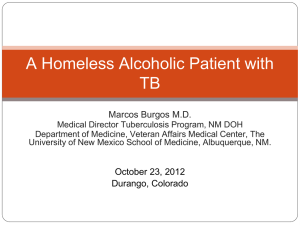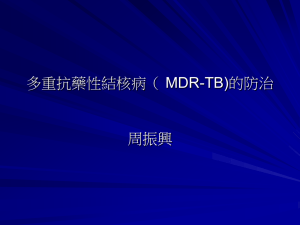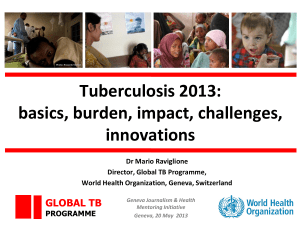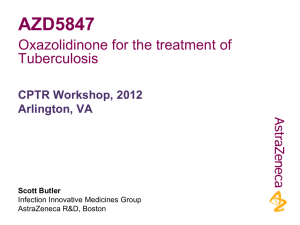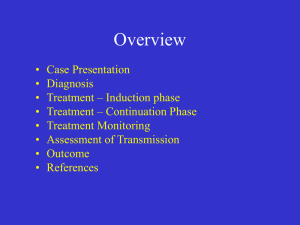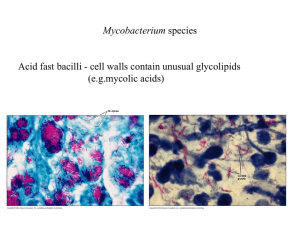Current TB treatment practices in the Philippines –V
advertisement
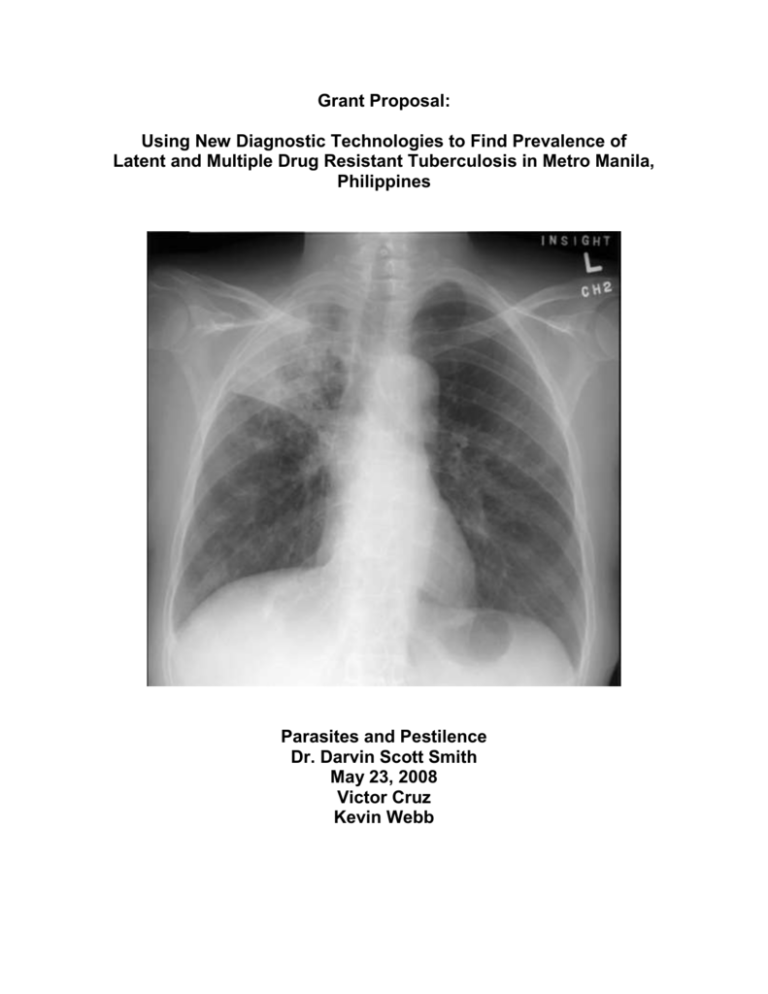
Grant Proposal: Using New Diagnostic Technologies to Find Prevalence of Latent and Multiple Drug Resistant Tuberculosis in Metro Manila, Philippines Parasites and Pestilence Dr. Darvin Scott Smith May 23, 2008 Victor Cruz Kevin Webb Cruz, Webb 1 Introduction This study seeks to enhance knowledge of tuberculosis prevalence in the Philippines. Tuberculosis is the main microbial killer of adults in the world, killing over 2 million people per year (Frieden) and infecting over one-third of the world's population (WHO). The Philippines has the 9th highest TB incidence worldwide (WHO) despite having free anti-TB medication (Philippine Department of Health) and a WHO approved TB infrastructure (WHO). According to one study, TB causes a loss of 500,000 DALYs in the Philippines every year (Peabody). This study aims to increase basic knowledge about the incidence of latent drug resistant tuberculosis and multi-drug resistant tuberculosis in the Metro Manila area of the Philippines. The current testing methods either cannot distinguish between MDR-TB and TB cases or are resource intensive. This lack of knowledge can lead to mistreatment and mismanagement of TB cases. A Rapid Molecular Diagnostic test (Genotype MTBDRplus assay) has been developed, but requires field-testing for WHO approval. In addition to helping prove the technology, data from these field tests can show the prevalence of MDR-TB and LTBI. This data is critical to focusing and developing cost-effective treatment programs. Specific Aims This project aims to find the rate of latent tuberculosis among residents of the densely populated District 6 of Metro Manila, as well as the rate of MDR-TB among TB patients in the district. To do this, the project will use the newly developed Rapid Molecular Diagnostic Test, which has a much higher rate of detection of symptomatic and asymptomatic TB than sputum tests do, and it can also reveal antibiotic resistance within Cruz, Webb 2 the TB. By doing this, we hope to create a new, better knowledge of the numbers of people affected by latent and MDR in District 6, and we hope that this knowledge will help public health officials to stop the disease's spread. Background History Primarily a respiratory disease, archaeological and genetic evidence indicates that most of the major forms of tuberculosis extant in humans today originated fifteen to twenty thousand years ago in Eastern Africa. As people migrated outward, so too did tuberculosis--archaeologists have found evidence of tuberculosis in millennia-old mummies from as far away as Egypt and Peru (Daniel). Although the Philippines' historical record is not as well understood as that of other regions, it is likely tuberculosis has existed in some form since the first human settlers colonized the islands around 50,000 years ago. Tuberculosis: A Life Cycle While tuberculosis can affect many different organ systems, it primarily affects the respiratory system. Once infected by aerosolized spray from a person with TB, a person may contract the disease. The bacterium takes up residence within the pulmonary alveoli, where it can lie dormant or reproduce. From there, it can spread to the kidneys, bone, or even the brain. When in active form, the tuberculosis bacterium can be coughed or spat out, aerosolizing in the process. This can then infect new hosts. Despite increasingly lower levels of TB through the past several centuries, the increasing rate of AIDS has made tuberculosis a growing threat. Currently, half of all people with AIDS will die of tuberculosis, meaning that finding ways to detect and treat Cruz, Webb 3 the disease is particularly critical. According to US AID, 293 people out of every 100,000 are infected with active tuberculosis. Latent and Multiple Drug Resistant TB Approximately 90% of people infected by TB will not develop symptoms. These individuals have what is called latent TB--a noninfective stage of low growth. When one of these people becomes immunocompromised, as with AIDS, however, the disease can emerge as active tuberculosis. An additional challenge with latent tuberculosis is that people who have active tuberculosis treated and then stop treatment prematurely once symptoms end is that the bacteria can then have time to develop resistance to first-line TB drugs. This resistant version of TB is known as MDR-TB. MDR-TB poses a threat to public health because, simply put, the more drugs that do not work on an infectious agent, the harder it is to stop the agent. Our study hopes to find out exactly what the rates of latent and MDR-TB are in Metro Manila. Current Tuberculosis Treatment The National Tuberculosis Programme in the Philippines is an approved DOTS program. In the Philippines, effective anti-tuberculosis drugs (isoniazid, rifampicin, Pyrazinamide, Ethambutol, and Streptomycin) are available for free-of-charge through national and local government health centers (Philippine Department of Health). At the same time, the Philippines has the 9th highest TB incidence worldwide and is one of three countries that account for 90% of all new TB cases in the Western Pacific Region (WHO factsheet). Various reasons have been cited for this discrepancy, including lower than expected use of the health centers (Auer) and failures to complete treatment. 53% of the population seeks care from private practitioners and end up paying for medications they could obtain for free (Auer). Further information on treatment practices may be obtained from the Comprehensive and Unified plan cited at the end of the paper. Cruz, Webb 4 Treatment is overall successful. According to one study in 2007, “the cure rate for new cases was 83.9% and failure was 0.01%, with corresponding rates in previously treated cases of 58.6% and 39.7%, respectively” (Quelapio). Current surveillance methods TB diagnosis centers on the DOTS protocol as well. The guidelines recommend that sputum culture be ordered in addition to sputum samples “primarily…for patients who are at risk for drug resistance.” The 1997 National Prevalence Survey cited that 46% of patients sought TB treatment with private physicians. In response to this issue, the current system in the Philippines consists of Public-Private Mixed DOTS (PPMD) (Tupasi PPMD). Detection of MDR-TB patients happens, if at all, after months of nonresponsive TB treatment. Patients are still infectious during this period. This practice happens because under current guidelines, sputum TB cultures are “primarily recommended for patients who are at risk for drug resistance” (Clinical Practice, 8). Amongst this population would be individuals with LTBI. Diagnosis: Sputum test and PPD The current method for testing for LTBI and MDR-TB involves the sputum test, as mandated by DOTS protocol (WHO, “Expanded DOTS Framework,” 14). According to the International Standards for Tuberculosis Care, DOTS requires threesamples be taken, when possible, at least one should be an early morning sample (2). The NTP Philippines Manual states midwives collect the sputum samples at rural and barangay (district) health centers. The test is shipped to a Microscopy Center for sputum culture or more rarely, drug susceptibility testing. Currently, there are 2 drug susceptibility testing centers and 6 culture centers in the Metro Manila area (Tupasi). One center has found “direct microscopy of a single sputum sample” to have sensitivity of only 30%-40% and a specificity >99% (Montoya). Diagnosis by smear turnaround Cruz, Webb 5 time has been cited as 24 hours. Diagnosis by culture is the “gold standard” but may take 6-8 weeks for results (Tiwaria). Currently, the only test approved for DOTS National Tuberculosis Plans is the bacteriological sputum test. However, sputum negative patients can still harbor infectious TB (Tanaya). Unfortunately, despite recommendations to diagnose TB with sputum smear and culture (National Tuberculosis Program), a 2001 study of private practitioners showed that 87.9% of practitioners diagnosed TB by X-ray instead (Portero and Rubio). This form of diagnosis is neither proven nor approved by the WHO. The sputum test, although required by DOTS program, may have issues with sensitivity, time to results and lack of use. Diagnosis by “gold standard” of culture may take 6-8 weeks. A recent study shows that private practitioners may not even be using the smear as recommended by national guidelines. For these reasons, this studies chooses to use the Genotype MTBDRplus molecular assay. A New Gold: Rapid Molecular Diagnostic Test The Genotype MTBDRplus molecular assay has been used successfully in a highvolume public health laboratory in Cape Town, Africa (Barnard). This test has a turnaround time as low as 8 hours and tests for the presence of tuberculosis as well as drug susceptibility. Typical turnaround time is about 24 hours. For sputum tests, these results are similar. However, the advantage to using this test for the study lies in the additional feature of drug susceptibility testing (DST), method of testing for MDR-TB, which normally takes weeks. The test has shown sensitivity for detection of rifampicin, isoniazid, and multidrug resistance as 99%, 100%, and 100%, respectively, on over 500 samples (Barnard). The specificity for detection of rifampicin, isoniazid, and multidrug resistance was 99, 100, and 100% respectively (Barnard). Other labs have found similar results (Hillemann). This performance “suggests that the assay is equivalent to Cruz, Webb 6 conventional Lowenstein-Jensen medium based DST performed in quality-assured reference laboratories (Barnard).” This study hopes to show the efficacy of this molecular assay in the Philippines. The use of the test has prior precedent in field tests in Africa. The decreased in-lab processing time, especially for DST will hopefully lead to much greater throughput of currently strained laboratories. Program Design Overview Our program is designed to measure the rates of latent TB in the general populace, as well as the rate of MDR-TB among people suffering from TB. We have chosen to use partners to give the tests, because almost anyone, medical training or not, can conduct the test, and because we feel that using partners with strong connections to the area will give us credibility and access to a broader, more representative swathe of people than our program would otherwise have alone. Location We have chosen to hold our study in District 6 of Metro Manila. This region has one of the highest population densities in the world, with equally high levels of poverty; experts estimate between 37 and over 50 percent of the city's inhabitants live in informal settlements (Shatkin). The region's density ensures that we will have a sufficiently large pool of data to draw from, while the region's poverty levels denote an increased susceptibility to the disease (Spence), as well as a greater likelihood of insufficient TB testing in the past. Additionally, because Metro Manila has one of the highest global population densities at 41,282 people per square kilometer (Official population count), it Cruz, Webb 7 is particularly important for government and public health officials to know what fraction of its citizenry has either latent or MDR-TB. Program One: Identify fraction of population with latent TB Overview In our first program, we aim to use the Rapid Diagnostic Test on asymptomatic citizens to detect the rate of latent tuberculosis among people not presenting symptoms. As latent tuberculosis is difficult to detect using older methods, we hope our study will generate an accurate picture of what fraction of the populace is actually infected with tuberculosis, active or latent, in a very quick and cost-efficient manner. The Tropical Disease Foundation We have chosen to partner with the Tropical Disease Foundation. In 1997 and 2007, TDF conducted a nationwide survey to determine rates of TB in the populace. They have worked with citizens and government before, and we find it most efficient to use the infrastructure they already have in place to access citizens, rather than building our own. Additionally, they already have engaged 17 local government units in Metro Manila to help combat MDR-TB in the coming months, meaning that they will have agents out in the field. Procedure a. Use the Tropical Disease Foundation to access 2700 citizens who form a roughly representative pool. This is approximately one percent of Metro Manila's District 6 population, meaning that we will have a representative fraction of the population without making the Topical Disease Foundation survey an unmanageable number of patients. Additionally, because the assumed rate of latent tuberculosis is lower than 5 percent, this number is high enough to find multiple people with latent TB. Cruz, Webb 8 b. Administer a survey to all tested to obtain relevant history of tuberculosis. This will help identify whether people with latent TB have been treated in the past for TB--if they have been treated and now have latent tuberculosis, they have a higher chance of developing MDR-TB later in life (Espinal). It also may provide insight into exposure a person has had, as well as any stigmas there are associated with the disease. c. Use Rapid Molecular Diagnostic Test to assess prevalence of latent TB and TB. The administrators of the test from the Tropical Disease Foundation will collect sputum samples from each of these patients, administer the test, and present our lab with the tested samples for processing. Based on previous studies, this process should take approximately 24 hours. From these routinely taken tests, we will, over the course of the study, develop an increasingly accurate picture of how many people in District 6 of Metro Manila have latent tuberculosis. Program Two: Determine the rate of MDR-TB Overview In this second test, we will perform the Rapid Molecular Diagnostic Test on patients already presenting TB symptoms. As the rate of MDR-TB is likely very low, to ensure that we obtain a sufficiently large sample size, we need to determine of MDR-TB among people with TB, rather than of MDR-TB among the average community. Philippine General Hospital Our partner for this program will be the Philippine General Hospital. A logical place to go for patients presenting tuberculosis symptoms, this hospital will see a significant number of patients with tuberculosis, meaning that the odds of finding people with MDR-TB are much higher. Although it is not necessary, their trained nurses will be especially useful Cruz, Webb 9 for safely and accurately administering the test. Finally, our study will help the hospital better allocate resources, as they will not waste money on first line drugs for patients who have MDR-TB. Procedure a. Identify 2000 patients presenting symptoms of tuberculosis at Philippine General Hospital. This pool of people is likely to be infected with TB, and so testing on them will likely result in finding some patients with MDR-TB. We chose to test 2000 individuals to ensure that we would find some with MDR-TB. b. Administer a survey to all tested to obtain relevant TB history. As with Program One, this survey will determine any past experiences with tuberculosis. Any past, only partly treated TB can re-emerge as MDR-TB. c. Run Rapid Molecular Diagnostic Test on all subjects to identify patients with TB or MDR-TB. The sputum samples will be collected by trained nurses and returned to our lab for running the RMD tests necessary. d. Assess the rate of MDR-TB among patients with TB. By dividing the number of people testing positive for MDR-TB by the number of people testing positive for TB, we will have a good idea of what fraction of the population with TB actually has MDR-TB. By multiplying this fraction with the fraction of District 6 residents with active tuberculosis, it will be easy to deduce the fraction of District 6 inhabitants with MDR tuberculosis. Potential Difficulties Our program may run into some issues. First of all, since we will depend upon our partners, we are also reliant on their sampling style. If, for example, the Tropical Disease Foundation tests only people of middle income, we will lack data for broad Cruz, Webb 10 swathes of the population and, worse, we might think that we do. Hopefully, a welldesigned survey will help prevent this from happening. Another concern is the possibility that our sample size may be insufficient. Fortunately, if our data seem to be inconsistent, we can simply test more citizens with relative ease. Finally, while initial tests have shown the Rapid Molecular Diagnostic Test highly effective and accurate, it still is a nascent technology, and problems could be encountered anywhere from its manufacture to how it is used. This could render our data useless. Overall Significance This study seeks to determine the incidence of latent TB in District 6 of Metro Manila as well as the current rate of MDR-TB infection. As latent TB infection often results from an active TB infection that was incompletely treated, it is likely to be a risk factor for developing MDR-TB (Espinal). LTBI requires a different suite of drug treatments than MDR-TB, as MDR-TB does not respond to some or all first-line drugs. LTBI is asymptomatic, but under the current physician guidelines posted by the National Tuberculosis Program of the Philippines, patients are only sent in for testing if they are symptomatic. As a result, LTBI prevalence is highly unknown, despite its role in MDRTB development. Effective drug therapies exist, and, according to the Comprehensive and Unified Policy for TB Control in the Philippines, should be provided free from the government. Knowledge of LTBI prevalence, however, is relatively unknown, and would be valuable for treatment. This study also seeks to determine the incidence of MDR-TB amongst TB patients in District 6 of Metro Manila. The prevalence of MDR-TB in the Philippines may Cruz, Webb 11 be underreported due to the National Tuberculosis Program guidelines and current health infrastructure. This information, however, is vital to the proper management of MDR-TB cases. Currently, there is a lack of LTBI and drug susceptibility testing in the Philippines, and with its high population density and its poverty, District 6 of Metro Manila seemed to us a good place to start to combat this dangerous lack of knowledge. Understanding these rates, we hope, will help public health and government officials to combat the disease more intelligently and to take greater strides toward eliminating it as quickly and efficiently as possible. In addition to helping through the uncovering of the rates of latent and MDR-TB, we hope the use of this Rapid Molecular Diagnostic Test will prove the functionality of the diagnostic itself and lead to a decrease in the amount of time and lab resources that it takes to perform the diagnostic. Cruz, Webb 12 Works Cited Alka M. Kanaya, David V. Glidden, Henry F. Chambers. “Identifying Pulmonary Tuberculosis in Patients with Negative Sputum Smear Results.” Chest (Vol 120: pg. 349-355). 2001. Auer, Christian, Jesus Sarol Jr, Marcel Tanner and Mitchell Weiss. “Health seeking and perceived causes of tuberculosis among patients in Manila, Philippines.” Tropical Medicine and International Health (Vol 5: 9 pg. 648–656). 2000. Barnard, Marinus, Heidi Albert, Gerrit Coetzee, Richard O’Brien, and Marlein E. Bosman. “Rapid Molecular Screening for Multidrug-Resistant Tuberculosis in a High-Volume Public Health Laboratory in South Africa.” American Journal of Respiratory Critical Care Medicine (Vol 177, pp 787–792). 2008. “Clinical Practice Guidelines for the Diagnosis, Treatment, Prevention and Control of Tuberculosis in Adult Filipinos: 2006.” Task force for Tuberculosis. 2006 Update. On-line available: http://www.psmid.org.ph/pdf/Introduction_Edited_4.pdf Accessed: May 2008. Daniel, Thomas M. "The History of Tuberculosis." Respiratory Medicine. 100.11 (September 01 2006). Department of Health, Government of the Philippines and Philippine Coalition Against Tuberculosis. “Comprehensive and Unified Policy for TB Control in the Philippines”. March 2003 Espinal, M. A. "Determinants of drug-resistant tuberculosis: analysis of 11 countries." International Journal of Tuberculosis and Lung Disease. 5.10 (November 10 2001): 887-893. Cruz, Webb 13 Frieden TR, Sterling TR, Munsiff SS, Watt CJ, Dye C. "Tuberculosis." The Lancet (Vol. 362: 887–99). 2003. Hillemann, Doris, Sabine Rüsch-Gerdes, and Elvira Richter. “Evaluation of the GenoType MTBDRplus Assay for Rifampin and Isoniazid Susceptibility Testing of Mycobacterium tuberculosis Strains and Clinical Specimens.” Journal of Clinical Microbiology (Vol 45:8 pg. 2635-2640) 2007. Hilleman D, et al. “Evaluation of the GenotypeMTBDRplus Assay for rifampicin and isoniazid susceptibility testing of Mycobacterium tuberculosis strains and in clinical specimens.” Journal of Clinical Microbiology (Vol 45: pg. 2635–2640). 2007. “International Standards for Tuberculosis Care.” Tuberculosis Coalition for Technical Assistance. March 22, 2006. <http://www.who.int/tb/publications/2006/istc_report_shortversion.pdf> Accessed: May 2008. Montoya, Jaime. “Newer Diagnostic Tests in Tuberculosis.” Philippine Journal of Microbiology and Infectious Disease (Vol 25:2). 1996. "Official Population Count Reveals." Philippines Census. Pub. 20 Apr. 2001. 20 May. 2008. <http://www.census.gov.ph/data/pressrelease/2001/pr0130tx.html>. Quelapio, Maria Imelda, Thelma E Tupasi, Nona Rachel C Mira, Maria Tarcela S Gler. “The Philippines case study.” Bulletin of the World Health Organization (Vol 85:5, 325-420). 2007. Shatkin, Gavin. Collective Action and Urban Poverty Alleviation. Google Scholar. 21 May 2008 <http://books.google.com/books?hl=en&lr=&id=z0ujkwsN_lwC&oi=fnd&pg=PR7& dq=metro+manila+poverty&ots=5SNUPlJ4NM&sig=PeOvPX2F2KEYgirzWb5VE Yk7-k#PPR10,M1>. Cruz, Webb 14 Spence, D. J. "Tuberculosis and Poverty." British Journal of Medicine. 307. (September 25 1993): 759-761. Tiwaria, Ram Pramod, Narendra S. Hattikudura, Ramesh N. Bharmalb, S. Kartikeyanc, Neeta M. Deshmukhd and Prakash S. Bisene. “Modern approaches to a rapid diagnosis of tuberculosis: Promises and challenges ahead.” Tuberculosis (Vol 87: 3, pg. 193-201) 2007. Tupasi, Thelma. Presentation. “DOTS-Plus in PPMD.” Tropical Disease Foundation. Meeting Stop TB. 16 October 2005 Tupasi, Thelma. “DOTS-PLUS for MDR-TB Management: Experience in The Philippines.” Presentation. Program Implementation Review (PIR) on Programmatic Management of MDR-TB (PMMT) implementation in the Philippines. December 20, 2007. Manila, Philippines. World Health Organization. “An Expanded DOTS Framework for Effective Tuberculosis Control.” Stop TB Communicable Diseases. Geneva, 2002. On-line available: http://whqlibdoc.who.int/hq/2002/WHO_CDS_TB_2002.297.pdf Accessed: May 2008 Works Referenced Philippine General Hospital Website. <http://www.pgh.gov.ph/v2/> Reichman, Lee B., and Earl S. Hershfield, eds. Tuberculosis: A Comprehensive International Approach. 144. New York, NY: Marcel Dekker, Inc., 2000. Tropical Disease Foundation Website. <http://www.tdf.org.ph/index.php>

